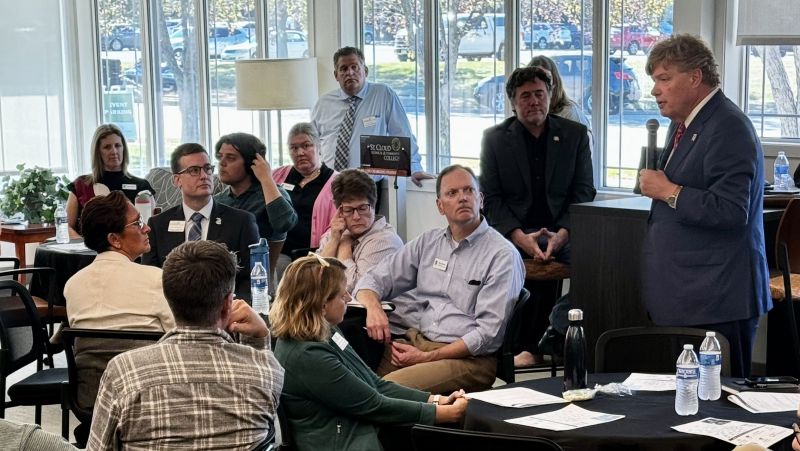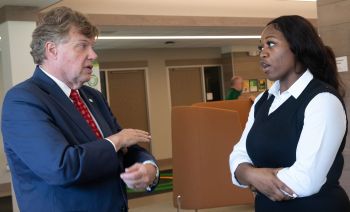
On Thursday, Sept. 26, community members gathered at the Heartland building to have a conversation with Minnesota State representatives and local legislators about the upcoming biennial budget request.
SCTCC President Lori Kloos welcomed the group of more than 50 people who filled the study area of the Library and thanked legislators, community members, St. Cloud State, SCTCC faculty and staff, and students who were present at the session.
Bill Maki, the Vice Chancellor of Finance and Facilities for Minnesota State, spoke next and shared the current biennial appropriation’s request and what was received. The four areas were Minnesota State stabilization; student support; workforce and economic development; and additional legislative funding that addressed enrollment loss during the pandemic. Maki spoke specifically about how SCTCC benefited from workforce and economic development dollars. He also mentioned how the student support dollars addressed basic needs and mental health funding but there were still unmet needs.
Chancellor Scott Olson greeted everyone and opened the listening sessions for discussion, which Kloos moderated.
Students, business owners, faculty, and others all contributed to the conversation around what the Minnesota State system should ask the state legislature to fund for the 2026-2027 biennium.
The topic of student basic needs was brought up right away and more than once during the discussion, with advocates imploring legislators to look at the whole, individual student rather than a cookie-cutter version. Even “small costs have a huge impact on our students,” said Dean of Liberal Arts and Sciences, Kelly Halverson.
Workforce needs and SCTCC’s current capacity for classroom space and faculty salaries were other matters that brought many people into conversation. With several trades industries seeing an increase in job openings due to retirements, now more than ever they need more workers, and they can’t hire SCTCC grads quickly enough.
People want to go into these high-demand programs, but the space SCTCC has is limited. In addition to that, many people can make more money in their industry than they can teaching, so to find faculty to teach the program is another barrier to adding more workforce. This is not just limited to trades; faculty from SCTCC’s health programs also advocated for more space to meet the increase in job openings. Students in attendance mentioned that they would like to see the current programs stabilized in this regard before adding new programs.
Infrastructure is one of the larger asks for the legislature, as the institutions around the state need to be maintained as they grow older. Jeff Wagner, SCTCC’s Vice President of Administration, brought attention to the roof of the Heartland Building where the session was taking place. The roof system needs to be replaced to repair leaks and failing tiles, as well as meet new building code. Before a remodel the second floor of the building takes place to open more structural capacity, the roof needs to be repaired.
This is all foundational to student success, which was a recurring topic.

“What are some things that you see in the community… for the best course of action to bring a mentorship program here, and not just at the community college level,” asked student and Cyclones Basketball athlete Kya Casseus. “Because student success isn’t just at the current college we’re at. Student success is through the workforce. When we’re walking across the stage. When we’re hopefully accepting our titles of legislator, mayor, and chancellor somewhere else.”
Olson wrapped up the session by sharing what themes he took away from this session that he will integrate with the eight other sessions from across the state. Minnesota State is hosting nine Listening Sessions across the state at its institutions so leaders can listen to priorities, concerns, and thoughts of key constituents. Insights from the sessions will inform the fiscal year 2026-2027 biennial budget request that the Board of Trustees will submit to the state in November 2024.
George Soule, Chair of the Board of Trustees, wrapped up the Listening Session, asking everyone to notice their handout with a state map of where all Minnesota State institutions are located: scattered across the state, with St. Cloud right in the middle.
Soule’s final missive to the legislature was that this higher education system, including SCSU and SCTCC, is a “uniquely state asset.”